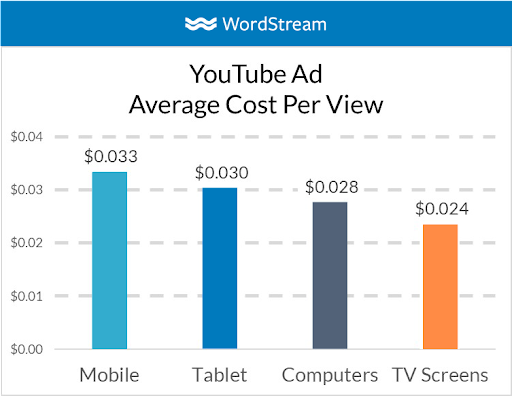
YouTube belongs to Google. You must put a bid for ad placement in order to pay for YouTube advertisements, just like with any other kind of Google AdWords campaign. As a result, it is hard to estimate the exact cost of YouTube advertisements.
In How To Make Money On YouTube, we previously examined YouTube ads from the perspective of YouTubers. This article focuses on YouTube from the perspective of advertising.
Your views will be added to your total YouTube viewer count, and YouTube ads typically pay $0.010 to $0.030 per view.
An average of $2,000 is spent to get 100,000 viewers.
More than 2.1 billion people check in to YouTube each month, which is a significant amount of users. They spend more than an hour every day, on average, watching YouTube on their mobile devices. YouTube viewing on televisions has rapidly increased along with the current popularity of Smart TVs.
It is also challenging to overlook the reality that Google and YouTube are the two most popular search engines.
It shouldn’t come as a surprise that YouTube has become a preferred platform for advertising worldwide given the strength of Google AdWords.
There is no specific price rate for YouTube advertising, which presents the only challenge in terms of budgeting. But this is just another form of online advertising, like many others. Online, it appears that the basic rule is that you bid for advertising space, and usually the highest bidder is accepted. To run YouTube ads you can check YouTube channel promotion.
Ad bumpers
Businesses employ bumper advertising when they want to provide potential customers a succinct, memorable message. They must be succinct because they are six seconds or less.
For bumper ads, you pay by impressions. They are compensated on a cost per thousand impressions (CPM) basis. So, every time your advertisement receives 1,000 impressions, you must pay for a bumper ad.
How to Target Your Video Ads
Each of your video campaigns has a Targets tab that you may access. It functions in a manner similar to how you would target certain demographic groups when you purchase Google Search AdWords.
The Targets tab is used to focus. You must only target the right people to view your ad if you want to keep the cost of your YouTube advertisements low and still obtain enough clicks for your campaign to be profitable.
Your target will be more narrowly defined the more targeting choices you select. For the majority of target groups, two to three targeting options should be adequate.
You should consider keywords when thinking. What key phrases will your target market probably use to look for YouTube videos?
The more you keep an eye on this, the less money you’ll waste on viewers who won’t proceed through the funnel after watching your films.
In general, you should steer clear of targeting video search phrases that are most frequently used by young females if you provide a product that is geared towards middle-aged men. For example, you wouldn’t want your advertisement to show on any of PewDiePie’s videos if you are marketing to senior women.
You should include both good keywords to concentrate on and bad keywords to steer clear of.
Additionally, you ought to consider different target demographics. You should refrain from advertising to the rest of the globe if you just sell your goods in that one nation. Similar to that, you might want to restrict your advertisement to nations where English is widely spoken.
Despite the fact that your films may be enjoyable, you do not want people to watch them through who are unlikely to ever purchase your stuff.
Bidding
The requirement to put bids for ad placement is the key to the amount of your YouTube advertising charges. You won’t be charged a predetermined rate to advertise on YouTube.
You decide how much you are willing to spend each day on your YouTube advertising budget. Most companies set aside at least $10 per day for their YouTube advertising efforts before increasing this amount after testing out different strategies. You only get paid when someone interacts with your advertisement. They might spend 30 seconds skipping your advertisement or click a display ad’s call to action.
Prior to deciding on your bidding possibilities, be sure to target. As you modify your targeting, YouTube will provide different bid suggestions.
You often bid using CPV, or cost per view. This indicates that you are prepared to spend as much as your bid amount for each view (lasting at least 30 seconds).
Additionally, you will choose the highest amount per day you are willing to spend. By doing this, you can be confident that you won’t have any unpleasant shocks if more people than you expected start watching your adverts.
A Max Cost Per View will be requested from you. You’ll receive a typical range of bids from YouTube; these will, of course, depend on how much you’ve targeted and constrained your audience.
You can split your bids individually for “In-Display” or “In-stream” by selecting “Customise Bids Per Format” from the menu. Bid higher for these data if “In-stream” advertising is more important to you than “In-Display.”
YouTube provides you with an estimate of the number of daily views you may expect from in-search, in-display, and in-stream. If these figures do not reflect your aims, you must revisit your bids and make the necessary adjustments.
You will receive the anticipated average CPV.
Making Your YouTube Campaigns More Effective
The degree of return you may expect from your YouTube advertising cost should ultimately be your main issue, not how much your YouTube Ads cost. This indicates that you must monitor your campaigns and then This means that in order to maximise the effectiveness of your initiatives, you must continuously monitor them and make necessary adjustments.
This is covered in How to Optimise a YouTube Ad Campaign by Neil Patel in great depth. He demonstrates how Gatorade was able to turn a $1 YouTube ad investment into $13.






